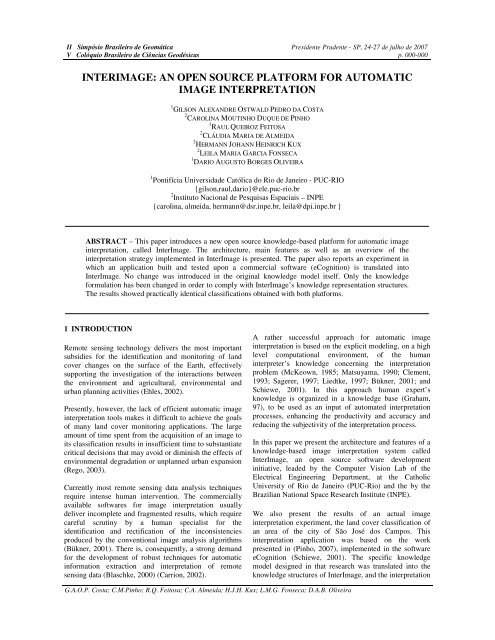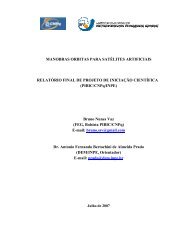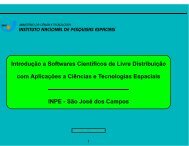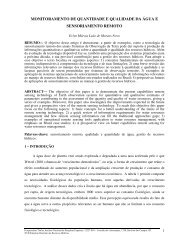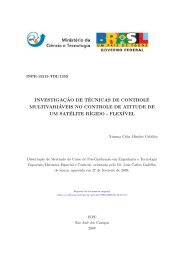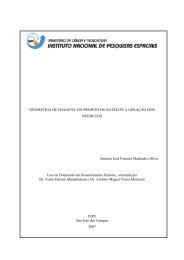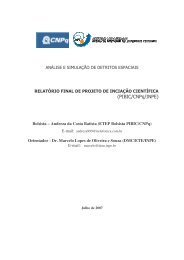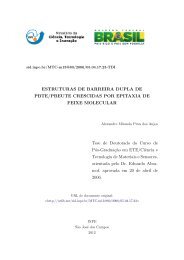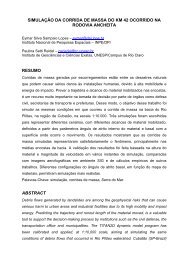interimage: an open source platform for ... - mtc-m17:80 - Inpe
interimage: an open source platform for ... - mtc-m17:80 - Inpe
interimage: an open source platform for ... - mtc-m17:80 - Inpe
Create successful ePaper yourself
Turn your PDF publications into a flip-book with our unique Google optimized e-Paper software.
II Simpósio Brasileiro de Geomática Presidente Prudente - SP, 24-27 de julho de 2007<br />
V Colóquio Brasileiro de Ciências Geodésicas p. 000-000<br />
INTERIMAGE: AN OPEN SOURCE PLATFORM FOR AUTOMATIC<br />
IMAGE INTERPRETATION<br />
1 GILSON ALEXANDRE OSTWALD PEDRO DA COSTA<br />
2 CAROLINA MOUTINHO DUQUE DE PINHO<br />
1 RAUL QUEIROZ FEITOSA<br />
2 CLÁUDIA MARIA DE ALMEIDA<br />
2 HERMANN JOHANN HEINRICH KUX<br />
2 LEILA MARIA GARCIA FONSECA<br />
1 DARIO AUGUSTO BORGES OLIVEIRA<br />
1 Pontifícia Universidade Católica do Rio de J<strong>an</strong>eiro - PUC-RIO<br />
{gilson,raul,dario}@ele.puc-rio.br<br />
2 Instituto Nacional de Pesquisas Espaciais – INPE<br />
{carolina, almeida, herm<strong>an</strong>n@dsr.inpe.br, leila@dpi.inpe.br }<br />
ABSTRACT – This paper introduces a new <strong>open</strong> <strong>source</strong> knowledge-based <strong>plat<strong>for</strong>m</strong> <strong>for</strong> automatic image<br />
interpretation, called InterImage. The architecture, main features as well as <strong>an</strong> overview of the<br />
interpretation strategy implemented in InterImage is presented. The paper also reports <strong>an</strong> experiment in<br />
which <strong>an</strong> application built <strong>an</strong>d tested upon a commercial software (eCognition) is tr<strong>an</strong>slated into<br />
InterImage. No ch<strong>an</strong>ge was introduced in the original knowledge model itself. Only the knowledge<br />
<strong>for</strong>mulation has been ch<strong>an</strong>ged in order to comply with InterImage’s knowledge representation structures.<br />
The results showed practically identical classifications obtained with both <strong>plat<strong>for</strong>m</strong>s.<br />
1 INTRODUCTION<br />
Remote sensing technology delivers the most import<strong>an</strong>t<br />
subsidies <strong>for</strong> the identification <strong>an</strong>d monitoring of l<strong>an</strong>d<br />
cover ch<strong>an</strong>ges on the surface of the Earth, effectively<br />
supporting the investigation of the interactions between<br />
the environment <strong>an</strong>d agricultural, environmental <strong>an</strong>d<br />
urb<strong>an</strong> pl<strong>an</strong>ning activities (Ehles, 2002).<br />
Presently, however, the lack of efficient automatic image<br />
interpretation tools makes it difficult to achieve the goals<br />
of m<strong>an</strong>y l<strong>an</strong>d cover monitoring applications. The large<br />
amount of time spent from the acquisition of <strong>an</strong> image to<br />
its classification results in insufficient time to subst<strong>an</strong>tiate<br />
critical decisions that may avoid or diminish the effects of<br />
environmental degradation or unpl<strong>an</strong>ned urb<strong>an</strong> exp<strong>an</strong>sion<br />
(Rego, 2003).<br />
Currently most remote sensing data <strong>an</strong>alysis techniques<br />
require intense hum<strong>an</strong> intervention. The commercially<br />
available softwares <strong>for</strong> image interpretation usually<br />
deliver incomplete <strong>an</strong>d fragmented results, which require<br />
careful scrutiny by a hum<strong>an</strong> specialist <strong>for</strong> the<br />
identification <strong>an</strong>d rectification of the inconsistencies<br />
produced by the conventional image <strong>an</strong>alysis algorithms<br />
(Bükner, 2001). There is, consequently, a strong dem<strong>an</strong>d<br />
<strong>for</strong> the development of robust techniques <strong>for</strong> automatic<br />
in<strong>for</strong>mation extraction <strong>an</strong>d interpretation of remote<br />
sensing data (Blaschke, 2000) (Carrion, 2002).<br />
A rather successful approach <strong>for</strong> automatic image<br />
interpretation is based on the explicit modeling, on a high<br />
level computational environment, of the hum<strong>an</strong><br />
interpreter’s knowledge concerning the interpretation<br />
problem (McKeown, 1985; Matsuyama, 1990; Clement,<br />
1993; Sagerer, 1997; Liedtke, 1997; Bükner, 2001; <strong>an</strong>d<br />
Schiewe, 2001). In this approach hum<strong>an</strong> expert’s<br />
knowledge is org<strong>an</strong>ized in a knowledge base (Graham,<br />
97), to be used as <strong>an</strong> input of automated interpretation<br />
processes, enh<strong>an</strong>cing the productivity <strong>an</strong>d accuracy <strong>an</strong>d<br />
reducing the subjectivity of the interpretation process.<br />
In this paper we present the architecture <strong>an</strong>d features of a<br />
knowledge-based image interpretation system called<br />
InterImage, <strong>an</strong> <strong>open</strong> <strong>source</strong> software development<br />
initiative, leaded by the Computer Vision Lab of the<br />
Electrical Engineering Department, at the Catholic<br />
University of Rio de J<strong>an</strong>eiro (PUC-Rio) <strong>an</strong>d the by the<br />
Brazili<strong>an</strong> National Space Research Institute (INPE).<br />
We also present the results of <strong>an</strong> actual image<br />
interpretation experiment, the l<strong>an</strong>d cover classification of<br />
<strong>an</strong> area of the city of São José dos Campos. This<br />
interpretation application was based on the work<br />
presented in (Pinho, 2007), implemented in the software<br />
eCognition (Schiewe, 2001). The specific knowledge<br />
model designed in that research was tr<strong>an</strong>slated into the<br />
knowledge structures of InterImage, <strong>an</strong>d the interpretation<br />
G.A.O.P. Costa; C.M.Pinho; R.Q. Feitosa; C.A. Almeida; H.J.H. Kux; L.M.G. Fonseca; D.A.B. Oliveira
II Simpósio Brasileiro de Geomática Presidente Prudente - SP, 24-27 de julho de 2007<br />
V Colóquio Brasileiro de Ciências Geodésicas<br />
executed over a subset of the same input data. A<br />
comparison of the results of the interpretation with both<br />
softwares was then per<strong>for</strong>med, showing almost identical<br />
results.<br />
In the remainder of this paper we describe the basic<br />
characteristics of the InterImage (Section 2) <strong>an</strong>d the<br />
interpretation strategy implemented by the system<br />
(Section 3). In Section 4 the l<strong>an</strong>d cover classification<br />
interpretation experiment is described, <strong>an</strong>d in Section 5<br />
the results of the experiment are presented. Finally, some<br />
conclusions <strong>an</strong>d directions <strong>for</strong> future work are stated in<br />
Section 6.<br />
2 SYSTEM DESCRIPTION<br />
InterImage is based on the software GeoAIDA (Bükner,<br />
2001), developed at the TNT Institute of the Leibniz<br />
H<strong>an</strong>nover University, Germ<strong>an</strong>y, <strong>an</strong>d it inherited from that<br />
system the basic functional design, knowledge structures<br />
<strong>an</strong>d control mech<strong>an</strong>isms. As a work in progress, a new<br />
graphical user interface, knowledge extraction<br />
functionality <strong>an</strong>d image processing operators are pl<strong>an</strong>ned<br />
to be included in InterImage in the near future.<br />
In short, InterImage implements a specific image<br />
interpretation strategy. A strategy based <strong>an</strong>d guided by a<br />
hierarchical description of the interpretation problem,<br />
structured in a sem<strong>an</strong>tic network.<br />
The basis <strong>for</strong> interpretation of digital image data are<br />
results generated with image processing operators. In this<br />
context, <strong>an</strong> image processing operator is <strong>an</strong>y operator that<br />
generates a labelled result image of a given image. Such<br />
image processing operators are denoted here as<br />
‘classifying operators’. They c<strong>an</strong> fulfil threshold<br />
operations, texture-based or model-based methods <strong>an</strong>d<br />
build the basis <strong>for</strong> the interpretation of a scene.<br />
In most of the systems that use sem<strong>an</strong>tic networks <strong>for</strong><br />
knowledge representation, only the leaf nodes of the<br />
network c<strong>an</strong> be associated to image processing operators.<br />
The following grouping of the objects often produces a<br />
very high combinational diversity, because all objects<br />
extracted from the image have to be taken into account at<br />
the same time.<br />
In InterImage, holistic operators (Liedtke, 1997) c<strong>an</strong> be<br />
used to reduce the combinational diversity problem.<br />
Holistic operators aim at identifying specific types of<br />
objects independently of the identification of their<br />
structural components. They c<strong>an</strong> be connected to <strong>an</strong>y<br />
node of the sem<strong>an</strong>tic network, <strong>an</strong>d their basic task is to<br />
divide a region into sub-regions, reducing the need of<br />
processing alternative interpretations. The structural<br />
interpretation of the sub-regions that follows c<strong>an</strong> verify or<br />
disprove the holistic results.<br />
Moreover, InterImage permits the integration of <strong>an</strong>y of<br />
such classifying operators in the interpretation process.<br />
The problem that different operators c<strong>an</strong> generate<br />
different in<strong>for</strong>mation <strong>for</strong> the same region in the image is<br />
solved by the use of additional knowledge regarding the<br />
judgment of the competing interpretations. Furthermore,<br />
as different operators c<strong>an</strong> process different types of data,<br />
the system permits the integrated <strong>an</strong>alysis of image <strong>an</strong>d<br />
GIS data from multiple <strong>source</strong>s.<br />
3 INTERPRETATION STRATEGY<br />
In InterImage explicit knowledge about the objects<br />
expected to be found in a scene is structured in a sem<strong>an</strong>tic<br />
network, defined by the user through the system’s graphic<br />
user interface (GUI).<br />
A sem<strong>an</strong>tic network, such as the one in Figure 1, contains<br />
nodes <strong>an</strong>d edges, whereat nodes represent concepts <strong>an</strong>d<br />
edges represent the relations between the concepts. In<br />
each concept node, in<strong>for</strong>mation necessary <strong>for</strong> the <strong>an</strong>alysis,<br />
such as the image processing operator specialised in the<br />
search of occurrences of the concept, is defined. During<br />
the <strong>an</strong>alysis, guided by the sem<strong>an</strong>tic network, the system<br />
controls the execution of the operators <strong>an</strong>d generates a<br />
network of inst<strong>an</strong>ces, each inst<strong>an</strong>ce defining a geographic<br />
region associated to a specific concept.<br />
Interpretation of remote sensing data me<strong>an</strong>s to tr<strong>an</strong>s<strong>for</strong>m<br />
input data into a structural <strong>an</strong>d pictorial description of the<br />
input data that represents the result of the <strong>an</strong>alysis. In<br />
InterImage, the result of the interpretation contains a<br />
structural description of the result (<strong>an</strong> inst<strong>an</strong>ce network)<br />
<strong>an</strong>d thematic maps. The final <strong>an</strong>d all intermediate results,<br />
in terms of region descriptions, are stored in XML <strong>for</strong>mat,<br />
<strong>an</strong>d c<strong>an</strong> be used <strong>for</strong> further external examinations.<br />
The <strong>an</strong>alysis process per<strong>for</strong>med by InterImage has two<br />
steps: a bottom-up step <strong>an</strong>d a top-down step. The topdown<br />
step is model driven <strong>an</strong>d generates a network of<br />
hypothesis based on the sem<strong>an</strong>tic network. The grouping<br />
of hypothesis <strong>an</strong>d their verification or falsification is a<br />
task of the data driven bottom-up <strong>an</strong>alysis. The final<br />
inst<strong>an</strong>ce network results from the bottom-up, data driven<br />
<strong>an</strong>alysis.<br />
In each node of the network the user defines the<br />
in<strong>for</strong>mation necessary <strong>for</strong> the execution of each<br />
processing step, that is, the image processing (classifying)<br />
operator <strong>an</strong>d respective parameters to be used in the topdown<br />
step (top-down operator), <strong>an</strong>d the decision rules to<br />
be used in the bottom-up step.<br />
The top-down operators have the task of separating<br />
regions into sub regions <strong>an</strong>d of building hypotheses <strong>for</strong><br />
the concepts of the sem<strong>an</strong>tic network, regions of the<br />
image associated to the concepts. The task is realized<br />
recursively from the upper to the lower nodes. For this<br />
purpose <strong>an</strong>y (external) image processing operator, which<br />
G.A.O.P. Costa; C.M.Pinho; R.Q. Feitosa; C.A. Almeida; H.J.H. Kux; L.M.G. Fonseca; D.A.B. Oliveira
II Simpósio Brasileiro de Geomática Presidente Prudente - SP, 24-27 de julho de 2007<br />
V Colóquio Brasileiro de Ciências Geodésicas<br />
creates hypotheses <strong>for</strong> the sub regions c<strong>an</strong> be used in the<br />
<strong>an</strong>alysis process. The sub regions hypotheses c<strong>an</strong> be<br />
defined by me<strong>an</strong>s of consistency measurements. If the<br />
contemplation of texture, <strong>for</strong> inst<strong>an</strong>ce, allows only a few<br />
possible hypotheses <strong>for</strong> a particular region, no further<br />
investigation of other concept hypotheses is per<strong>for</strong>med <strong>for</strong><br />
that region.<br />
When the top-down-<strong>an</strong>alysis reaches the leaf nodes, the<br />
<strong>an</strong>alysis turns from model driven interpretation to data<br />
driven interpretation (bottom-up). The decision rules <strong>for</strong><br />
the bottom-up step are defined in a particular stack based<br />
l<strong>an</strong>guage that provides functions <strong>for</strong> deciding between<br />
spatially concurrent hypotheses generated in the top-down<br />
step.<br />
4 EXPERIMENT DESIGN<br />
eCognition project, the marginal differences are due to<br />
particularities of the different interpretation strategies of<br />
the two systems.<br />
The experiment implemented in this work was designed<br />
to evaluate the per<strong>for</strong>m<strong>an</strong>ce of InterImage in a specific<br />
interpretation application, already implemented with<br />
<strong>an</strong>other knowledge-based system, in this case, the system<br />
eCognition, distributed commercially by the comp<strong>an</strong>y<br />
Definiens AG, that is virtually the only knowledge-based<br />
image interpretation system available. In doing so, we<br />
also w<strong>an</strong>ted to investigate the possibility of tr<strong>an</strong>sporting<br />
to InterImage a knowledge model implemented with the<br />
aid of eCognition.<br />
The selected application was the one described at (Pinho,<br />
2007), which produced <strong>an</strong> automatic l<strong>an</strong>d cover<br />
classification of <strong>an</strong> area of the city of São José dos<br />
Campos. The specific knowledge model designed <strong>for</strong> the<br />
application, described in terms of the knowledge<br />
structures defined in the eCognition system, was<br />
tr<strong>an</strong>slated into the knowledge structures of InterImage.<br />
The same set of input data (a Quickbird image <strong>an</strong>d GIS<br />
vector data with street limits) was used. In this<br />
experiment, however, only a 129,600 m 2 subset of the<br />
original Quickbird scene was interpreted.<br />
Figure 1 – Sem<strong>an</strong>tic Network<br />
5 EXPERIMENT RESULTS<br />
Figure 2 shows the interpretation results in terms of a<br />
thematic map depicting the final classification per<strong>for</strong>med<br />
with InterImage.<br />
As the focus of the experiment was on the tr<strong>an</strong>slation of<br />
the eCognition knowledge model to InterImage, we<br />
decided to purge eventual differences in the initial region<br />
hypothesis <strong>an</strong>d in the measurements of those regions from<br />
the <strong>an</strong>alysis. That was done by using the same segments<br />
generated by the eCognition segmentation algorithm (<strong>for</strong><br />
the first segmentation level of that particular application),<br />
<strong>an</strong>d also same feature values <strong>for</strong> the segments. A special<br />
top-down operator was implemented <strong>for</strong> that purpose. The<br />
operator imports the segmentation (image objects) <strong>an</strong>d<br />
respective feature values exported by eCognition.<br />
Also implemented <strong>for</strong> the application was a function that<br />
calculates fuzzy membership values, to be used in the<br />
decision rules of the bottom-up interpretation step. Figure<br />
1 shows the sem<strong>an</strong>tic network defined in InterImage. It<br />
should be noted that the network designed in InterImage<br />
is very similar to the Class Hierarchy defined in the<br />
Figure 2 – Classification Results<br />
Table 1 shows the confusion matrix between the two<br />
classifications. The rows of the matrix show the<br />
classification results obtained with InterImage <strong>an</strong>d the<br />
columns show the results obtained by eCognition.<br />
G.A.O.P. Costa; C.M.Pinho; R.Q. Feitosa; C.A. Almeida; H.J.H. Kux; L.M.G. Fonseca; D.A.B. Oliveira
II Simpósio Brasileiro de Geomática Presidente Prudente - SP, 24-27 de julho de 2007<br />
V Colóquio Brasileiro de Ciências Geodésicas<br />
Table 1 – Confusion Matrix<br />
eCognition<br />
InterImage<br />
Asphalt<br />
Metallic Cover<br />
Light Concrete<br />
Asbestos<br />
Medium Concrete<br />
Asbestos<br />
Dark Concrete<br />
Swimming Pool<br />
Bare Soil<br />
Shadow<br />
Ceramic Tile<br />
Trees<br />
Grass<br />
Total<br />
Asphalt 3<strong>80</strong> 1 381<br />
Metallic Cover 109 109<br />
Light Concrete<br />
Asbestos<br />
Medium Concrete<br />
Asbestos<br />
65 65<br />
632 11 4 647<br />
Dark Concrete 49 446 495<br />
Swimming Pool 2 2<br />
Bare Soil 99 21 120<br />
Shadow 450 450<br />
Ceramic Tile 4 93 1090 1187<br />
Trees 1130 1130<br />
Grass 4 323 327<br />
Total 429 109 65 636 447 2 203 450 1115 1134 323 4913<br />
The global result in terms of the overall coincidence in<br />
the two classifications is 96.2%. The small difference<br />
in the classification c<strong>an</strong> be explained by a precision<br />
problem, related to the fuzzy sets defined in the<br />
eCognition knowledge model. As there is no way to<br />
extract precise <strong>for</strong>mulation of the fuzzy sets, defined<br />
graphically by the user through eCognition’s GUI, the<br />
shape of the fuzzy sets in InterImage was <strong>an</strong><br />
approximation of the original ones. That conclusion is<br />
supported by the fact that the confusion occurred<br />
basically between classes that have similar<br />
characteristics, such as Asphalt <strong>an</strong>d Dark Concrete,<br />
<strong>an</strong>d Ceramic Tile <strong>an</strong>d Exposed Soil.<br />
6 CONCLUSION<br />
This work introduced InterImage, a new knowledgebased<br />
image interpretation <strong>plat<strong>for</strong>m</strong> being developed in<br />
accord<strong>an</strong>ce to the <strong>open</strong> <strong>source</strong> philosophy. The paper<br />
also reported <strong>an</strong> experiment version in which <strong>an</strong><br />
interpretation model built in eCognition was tr<strong>an</strong>slated<br />
into the current InterImage version. The classification<br />
results achieved by both software <strong>plat<strong>for</strong>m</strong>s were very<br />
similar.<br />
In terms of interpretation strategy InterImage has a<br />
more flexible architecture th<strong>an</strong> eCognition. The<br />
combination of a model-driven followed by a datadriven<br />
<strong>an</strong>alysis, as per<strong>for</strong>med by InterImage, has the<br />
potential of <strong>an</strong> improved computational efficiency in<br />
comparison to eCognition that follows a pure datadriven<br />
strategy. Thus InterImage offers knowledge<br />
modelling features not available in eCognition.<br />
The experiment described in this paper provides<br />
evidence that most interpretation models built on<br />
eCognition may be tr<strong>an</strong>sposed to InterImage. For the<br />
particular application taken as example in this paper,<br />
time was mostly spent in re<strong>for</strong>mulating the fuzzy rules<br />
in the InterImage environment. As the InterImage<br />
project evolves, the task of tr<strong>an</strong>slating the eCognition<br />
models into InterImage will certainly become much<br />
easier<br />
Further development of InterImage has been already<br />
pl<strong>an</strong>ned. Implementation of multi-temporal<br />
capabilities, automatic knowledge extraction functions,<br />
as well as built-in image processing operators are some<br />
of the developments envisaged <strong>for</strong> the near future.<br />
G.A.O.P. Costa; C.M.Pinho; R.Q. Feitosa; C.A. Almeida; H.J.H. Kux; L.M.G. Fonseca; D.A.B. Oliveira
II Simpósio Brasileiro de Geomática Presidente Prudente - SP, 24-27 de julho de 2007<br />
V Colóquio Brasileiro de Ciências Geodésicas<br />
AKNOWLEGMENTS<br />
The authors acknowledge the support provided by<br />
FAPERJ (Fundação de Amparo à Pesquisa do Estado<br />
do Rio de J<strong>an</strong>eiro) <strong>an</strong>d FINEP (Fin<strong>an</strong>ciadora de<br />
Estudos e Projetos).<br />
REFERENCES<br />
BLASCHKE, T.; LANG, S.; LORUP, E.; STROBL, J.;<br />
ZEI, P. Object-oriented image processing in <strong>an</strong><br />
integrated GIS/remote sensing environment <strong>an</strong>d<br />
perspectives <strong>for</strong> environmental applications. In:<br />
CREMERS, A., GREVE, K. (Eds.). Environmental<br />
In<strong>for</strong>mation <strong>for</strong> Pl<strong>an</strong>ning, Politics <strong>an</strong>d the Public.<br />
Marburg: Metropolis-Verlag, 2000. 2 v. p.555-570.<br />
BÜCKNER, J.; PAHL, M.; STAHLHUT, O.;<br />
LIEDTKE, C.-E. GEOAIDA - A Knowledge Based<br />
Automatic Image Data Analyzer <strong>for</strong> Remote Sensing<br />
Data. In: ICSC CONGRESS ON COMPUTATIONAL<br />
INTELLIGENCE METHODS AND APPLICATIONS<br />
2001 - CIMA 2001, B<strong>an</strong>gor, Wales, UK. Proceedings<br />
of The Congress on Computational Intelligence<br />
Methods <strong>an</strong>d Applications 2001 - CIMA 2001 (CD-<br />
ROM).<br />
CARRION, D.; GIANINETTO, M.; SCAIONI, M.<br />
GEOREF: A Software <strong>for</strong> Improving the Use of<br />
Remote Sensing Images in Environmental<br />
Applications. In: IEMSS 2002 - INTEGRATED<br />
ASSESSMENT AND DECISION SUPPORT, 2002,<br />
Lug<strong>an</strong>o, Switzerl<strong>an</strong>d. Proceedings of IEMSS 2002, 2<br />
v., pp. 360.<br />
CLÉMENT, V.; GIRAUDON, G.; HOUZELLE, S.;<br />
SANDAKLY, F. Interpretation of Remotely Sensed<br />
Images in a Context of Multisensor Fusion Using a<br />
Multispecialist Archteture. IEEE Tr<strong>an</strong>sactions on<br />
Geoscience <strong>an</strong>d Remote Sensing, v. 31, n. 4, p. 779-<br />
791, jul. 1993.<br />
EHLERS, M.; JANOWSKY, R.; GÄHLER, M. New<br />
Remote Sensing Concepts <strong>for</strong> Environmental<br />
Monitoring. In: Ehlers, M. (Ed.), Conf. Remote<br />
Sensing <strong>for</strong> Environmental Monitoring, GIS<br />
Applications, <strong>an</strong>d Geology, 2002, Bellingham, WA.<br />
Proceedings SPIE, Vol. 4545, p.1-12,<br />
GRAHAM, J.; JONES, P.: Knowledge-Based Image<br />
Processing Systems. London: Springer-Verlag, 1997.<br />
178 p.<br />
LIEDTKE, C.-E.; BÜCKNER, J.; GRAU, O.;<br />
GROWE, S.; TÖNJES, R. AIDA: A System <strong>for</strong> the<br />
Knowledge Based Interpretation of Remote Sensing<br />
Data, In: THIRD INTERNATIONAL AIRBORNE<br />
REMOTE SENSING CONFERENCE AND<br />
EXHIBITION, 1999, C<strong>open</strong>hagen, Denmark,<br />
Proceedings of the Third International Airborne<br />
Remote Sensing Conference <strong>an</strong>d Exhibition.<br />
Environmental Research Institute of Michig<strong>an</strong>, AGU,<br />
1997.<br />
MATSUYAMA, T.; HWANG, V. Adv<strong>an</strong>ces in<br />
computer vision <strong>an</strong>d machine intelligence. SIGMA: A<br />
knowledge-base aerial image underst<strong>an</strong>ding system.<br />
New York: Plenum, 1990. ISBN: 030643301X.<br />
MCKEOWN, D. M.; HARVEY, W. A.;<br />
MCDERMOTT, J. Rule Based interpretation of aerial<br />
imagery. IEEE Tr<strong>an</strong>sactions on Pattern Analysis<br />
<strong>an</strong>d Machine Intelligence, v. 7, n. 5, p. 570-585,<br />
1985.<br />
PINHO, C.M.D., KUX, H., ALMEIDA, C.M.<br />
Elaboração de rede semântica para classificação de<br />
cobertura do solo de ambientes intra-urb<strong>an</strong>os: o Caso<br />
de São José dos Campos - SP, Brasil. In: XIV<br />
SIMPÓSIO BRASILEIRO DE SENSOREAMENTO<br />
REMOTO – SBSR, 2007, Flori<strong>an</strong>ópolis, Brasil.<br />
Proceedings of the XIV Simpósio Brasileiro de<br />
Sensoreamento Remoto – SBSR 2007. In press.<br />
REGO, L. F. G.; Automatic l<strong>an</strong>d-cover classification<br />
derived from high-resolution IKONOS satellite<br />
image in the urb<strong>an</strong> atl<strong>an</strong>tic <strong>for</strong>est in Rio de J<strong>an</strong>eiro,<br />
Brasil by me<strong>an</strong>s of <strong>an</strong> objects-oriented approach.<br />
2003. 193p. Tese (Forstwissenschaftlichen Fakultät).<br />
Albert-Ludwigs-Universität.2003<br />
PINHO, C.M.D. Análise orientada a objetos de<br />
imagens de satélite de alta resolução espacial<br />
aplicada à classificação de cobertura do solo no<br />
espaço intra-urb<strong>an</strong>o: o caso de São José dos<br />
Campos-SP, São José dos Campos, 181 p.<br />
Dissertação (Mestrado em Sensoriamento Remoto,<br />
INPE, 2005 (INPE-14183-TDI/1095).<br />
SAGERER, G.; NIEMANN, H. Sem<strong>an</strong>tic Networks <strong>for</strong><br />
Underst<strong>an</strong>ding Scenes. Adv<strong>an</strong>ces in Computer Vision<br />
<strong>an</strong>d Machine Intelligence. 1.ed. New York: Plenum<br />
Publishing Corporation, 1997. 500p. ISBN:<br />
0306457040.<br />
SCHIEWE, J., TUFTE, L., EHLERS, M.,. Potential<br />
<strong>an</strong>d Prolems of multi-scale segmentation methods in<br />
remote sensing. GIS-In<strong>for</strong>mationsysteme, v. 6, pp. 34-<br />
39, 2001.<br />
G.A.O.P. Costa; C.M.Pinho; R.Q. Feitosa; C.A. Almeida; H.J.H. Kux; L.M.G. Fonseca; D.A.B. Oliveira


